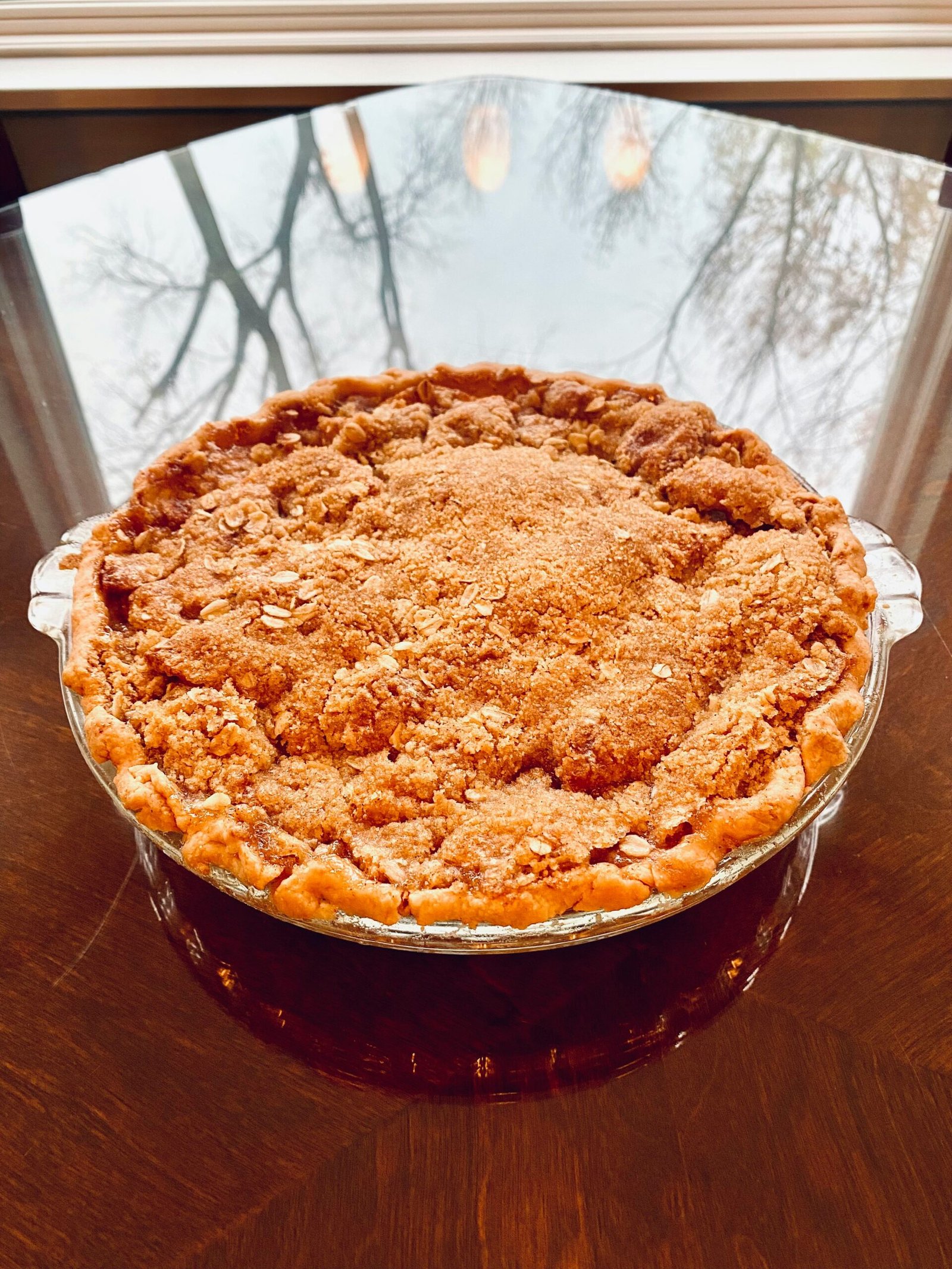Introduction to the Dish
The Southern New Year’s dish, comprising ham, greens, and black-eyed peas, is not merely a meal but a rich cultural tradition steeped in history. Its origins can be traced back to various Southern states where the combination of these ingredients signifies prosperity and good fortune for the upcoming year. Each component holds its own significance: ham symbolizes wealth and abundance, greens represent monetary gain, and black-eyed peas are believed to bring luck, especially when prepared in plentiful quantities. This culinary trio has become synonymous with New Year’s celebrations in the South.
Historically, these ingredients have roots in African American culture, reflecting a blend of African traditions and Southern agricultural practices. The association with New Year’s Day is particularly poignant; many believe that consuming these dishes on January 1st will ensure blessings for the year ahead. The traditional preparation often involves slow-cooking the black-eyed peas with savory seasonings, while the greens, such as collard or mustard greens, are typically sautéed or simmered to enhance their flavor.
This festive dish is often enjoyed in a communal setting, fostering a sense of togetherness among family and friends. In addition to its culinary role, the meal embodies sentiments of hope and renewal, common themes during holiday gatherings. As families come together to share stories, laughter, and of course, this auspicious spread, the act of sharing the dish becomes a ritual that reinforces cultural heritage and familial bonds.
In numerous Southern households, the preparation and consumption of ham, greens, and black-eyed peas on New Year’s Day is a cherished tradition, reflecting a vibrant history and optimism for the future. Each serving of this hearty meal carries with it the aspirations tied to new beginnings, making it a celebration of both food and culture.
Cultural Significance
The traditional Southern New Year’s dish of ham, greens, and black-eyed peas embodies a rich tapestry of cultural meanings and historical practices that reflect the hopes and aspirations associated with the new year. Each component of this dish carries its own unique significance, particularly in the context of prosperity, good fortune, and wealth.
Starting with ham, this ingredient symbolizes abundance and prosperity. In many cultures, consuming ham during the New Year’s celebrations is believed to bless the upcoming year with a bountiful harvest and affluence. The pork’s association with richness stems from the animal’s inclination to root forward—signifying progress and the pursuit of good fortune in the new year. In Southern households, the presence of ham on the dining table serves as a hopeful token for financial stability and a prosperous year ahead.
Complementing the ham, black-eyed peas are widely regarded as a powerful emblem of good luck. Traditionally, these legumes are consumed on New Year’s Day as a means of attracting luck and warding off misfortune. It is said that each pea symbolizes a penny, and consuming them can offer prosperity throughout the year. Originating from African American folklore, this practice emphasizes the belief that these small beans can significantly impact one’s fortune, encouraging a mindset filled with optimism as the year begins.
Lastly, the greens, often collard or turnip greens, represent wealth. Their vibrant color and leafy abundance are seen as symbols of currency and financial growth. Eating greens is a customary way to invite economic prosperity into one’s life, drawing from the notion that their green hue mirrors the color of money. Incorporating greens into New Year’s meals aligns with the collective hope for wealth and resources, exhibiting a profound connection to the values and beliefs held throughout Southern culture.
These three components—ham, greens, and black-eyed peas—intertwine to create a meal that is laden with cultural significance, revealing an enduring tradition steeped in the desire for a successful and prosperous year ahead.
Ingredients List
To prepare a traditional Southern New Year’s dish featuring ham, greens, and black-eyed peas, it is essential to gather the precise ingredients to ensure optimal flavor and authenticity. Below is a comprehensive list of the main components along with the necessary measurements.
For the Ham:
- 1 fully cooked ham (about 5-7 pounds)
- 1 cup of honey or brown sugar for glazing
- 2 tablespoons of Dijon mustard
- 1 cup of pineapple juice (optional, for added flavor)
For the Greens:
- 1 pound of collard greens (washed and chopped)
- 1 pound of mustard greens (washed and chopped)
- 1 pound of turnip greens (washed and chopped)
- 1 tablespoon of olive oil or bacon drippings
- 3 cloves of garlic (minced)
- 4 cups of chicken or vegetable broth
- Salt and pepper to taste
For the Black-Eyed Peas:
- 1 pound of dried black-eyed peas (soaked overnight and drained)
- 4 cups of water or broth for cooking
- 1 onion (chopped)
- 1-2 smoked ham hocks or turkey legs for flavor
- 1 teaspoon of cayenne pepper (optional, for heat)
- Salt and pepper to taste
This ingredient list provides everything needed to create a delightful and hearty Southern New Year’s meal. Each ingredient not only contributes to the dish’s essential flavors but also adheres to the tradition of celebrating the New Year with a meal believed to bring good luck and prosperity. Preparing these items ahead of time will facilitate a smooth cooking process and enhance the overall dining experience.
Cooking Equipment Needed
Preparing a classic Southern New Year’s dish of ham, greens, and black-eyed peas requires a variety of kitchen equipment to ensure that the process is efficient and enjoyable. Whether you are a seasoned cook or a novice, having the proper tools will significantly enhance your cooking experience.
First and foremost, a large stockpot is essential for cooking black-eyed peas. A pot with a capacity of at least 6 quarts is advisable, allowing enough room for the peas to expand while cooking. Additionally, a heavy-bottomed skillet or sauté pan is needed to prepare the greens. This type of pan distributes heat evenly and is ideal for wilting greens such as collard or mustard greens.
You will also require a roasting pan for the ham. A sturdy roasting pan with a rack allows the ham to cook evenly and promotes better airflow, ensuring a beautifully glazed exterior. A basting brush or mop is recommended for applying marinades or glazes to the ham, enhancing its flavor and moisture.
Utensils such as a sharp chef’s knife, cutting board, and tongs are vital for preparing and serving the dish. The chef’s knife will help with chopping and slicing ingredients efficiently, while tongs will aid in turning the greens or moving the ham without damaging it. For measuring ingredients accurately, a set of measuring cups and spoons should be readily available.
Lastly, consider using a slow cooker or Instant Pot for the black-eyed peas. These appliances can save time and allow for a hands-off cooking process, making it easier to balance the different components of your meal. By gathering the appropriate cooking equipment, you will set yourself up for a successful culinary experience this New Year’s Day.
Preparation Steps for the Ingredients
To successfully prepare the Southern New Year’s dish of ham, greens, and black-eyed peas, it is essential to meticulously handle each ingredient to enhance flavor and texture. Begin with the black-eyed peas, which require soaking. Rinse the peas under cold water to remove any debris or impurities. After rinsing, place them in a large bowl, cover them with water, and allow them to soak for at least six hours or overnight. This will help soften the peas and reduce the cooking time later.
Next, focus on the greens, typically collard greens, mustard greens, or turnip greens. Start by cleaning the greens thoroughly. Fill a large bowl with cold water and submerge the greens to rinse away any dirt. Change the water a couple of times if necessary. After cleaning, remove tough stems and chop the leaves into manageable pieces, roughly three to four inches in size. This will allow the greens to cook evenly and absorb the flavors of the dish.
Moving on to the ham, select a cut that suits your taste; a smoked ham hock or shank works exceptionally well. If you are using a fresh ham, require a marinade or rub to penetrate the meat, enhancing its natural flavors. Score the surface of the ham lightly in a diamond pattern to allow seasoning to seep in. Depending on the recipe, you may want to glaze or season it with a blend of brown sugar, mustard, and black pepper for a beautiful crust and rich taste.
Lastly, gather your seasonings such as onion, garlic, and spices, ensuring they are fresh and ready for use. For the onion and garlic, peel and finely chop them, releasing their aromatic qualities that will contribute significantly to the overall flavor. By carefully preparing each ingredient, you will set the foundation for a delicious and traditional Southern New Year’s meal that exemplifies warmth and festivity.
Step-by-Step Cooking Instructions
Creating a traditional Southern New Year’s dish of ham, greens, and black-eyed peas is a rewarding process that combines rich flavors and cultural significance. Follow these detailed steps to ensure a successful meal.
Start by preparing the ham. Choose a well-seasoned, bone-in ham for optimal flavor. Preheat your oven to 325°F (163°C). In a roasting pan, place the ham cut side down. An optional glaze of brown sugar, mustard, and honey can be applied for extra sweetness. Roast the ham for approximately 15 to 18 minutes per pound, or until the internal temperature reaches 140°F (60°C). Baste the ham occasionally to maintain moisture.
While the ham is roasting, begin prepping the black-eyed peas. Rinse and sort through the peas to remove any debris. Soak them overnight in water to hydrate, or for a quicker option, use the quick-soak method by boiling them for about 5 minutes and letting them sit for an hour. Then, drain and transfer the peas to a large pot. Add fresh water, about two inches above the peas, and season with salt, garlic, and onion. Bring to a boil, then reduce heat and simmer for 45 minutes to an hour, or until tender.
Now, prepare the greens, such as collard greens or turnip greens. Remove any tough stems and chop the leaves into bite-sized pieces. In a separate pot, heat some oil and sauté diced onions and minced garlic until translucent. Add the greens, along with chicken broth (or water), and season with salt, pepper, and crushed red pepper flakes for added heat. Cover and cook on medium heat for about 30 minutes until the greens are tender.
Once all components are ready, slice the ham and serve it alongside the black-eyed peas and greens, garnishing with a sprinkle of fresh herbs if desired. This delectable meal is both a feast for the senses and a symbol of good fortune for the coming year.
Common Mistakes to Avoid
When preparing the classic Southern New Year’s dish of ham, greens, and black-eyed peas, home cooks may face several common pitfalls that can impact the overall quality and flavor of the meal. One of the primary mistakes is overcooking the ingredients, which can lead to compromised texture and diminished taste. To prevent this, it is crucial to monitor cooking times closely, especially for the greens and black-eyed peas. Greens, such as collard or turnip, should be cooked until tender but still vibrant in color; too much time in the pot can result in a mushy, unappetizing texture. Similarly, black-eyed peas should be cooked until just tender, ensuring they retain their shape and flavor.
Another frequent issue is the imbalance of flavors between the ingredients. The ham provides a rich, smoky flavor, while greens typically offer a slightly bitter taste that can overpower the dish if not balanced correctly. To maintain harmony in flavors, consider incorporating various seasonings such as garlic, onion, and a touch of vinegar to brighten up the overall profile. Experimenting with the right amounts will ensure that no single ingredient dominates, enhancing the dish’s complexity.
Timing is essential when preparing this meal. Many home cooks may not realize that preparing all components simultaneously can lead to cold or lukewarm servings. One effective strategy is to start with the ham and allow it to warm through, while the black-eyed peas and greens are prepared separately but within close timeframes. This method will better allow the flavors to meld without sacrificing temperature. By maintaining attention to cooking times, balancing flavors, and coordinating the preparation, home cooks can significantly improve their chances of creating a perfect Southern New Year’s dish.
Serving Suggestions
When it comes to presenting the classic Southern New Year’s dish of ham, greens, and black-eyed peas, the aesthetic and pairing can elevate the dining experience significantly. Start by using a large, rustic wooden platter for a more casual, homestyle presentation, or opt for elegant white dinnerware to create a refined atmosphere. Arrange slices of the ham in a fan shape, draping the greens artistically around the edges while placing the black-eyed peas in a small bowl for spooning. Garnishing with fresh herbs, such as parsley or dill, can add a vibrant touch and make the dish visually appealing.
Pairing this dish with complementary sides can enhance its flavors. Traditional Southern cornbread is a perfect addition, providing a delightful contrast in texture and a touch of sweetness. Alternatively, consider serving a light coleslaw or a fresh vegetable salad to balance the richness of the ham and provide a refreshing crunch. For a more extravagant touch, include some roasted root vegetables, such as sweet potatoes or carrots, which can bring additional color and flavor to the table.
Drinks play a crucial role in any meal, and a classic Southern sweet tea or lemonade can be a great choice, offering a refreshing contrast to the savory main course. For those preferring something a bit stronger, a glass of bourbon or a light white wine, such as a Sauvignon Blanc, would complement these flavors well. Finally, dessert can be a delightful way to round off the meal. A slice of pecan pie or a bowl of peach cobbler serves both as a nod to Southern culinary tradition and as a delightful end to your New Year’s feast.
Tips for Making Ahead
Preparing Ham, Greens, and Black Eyed Peas ahead of time can significantly ease the stress of holiday cooking, especially when catering for large gatherings. To make this Southern New Year’s recipe more manageable, consider batch cooking some components in advance. Begin with the black-eyed peas, which can be soaked overnight to reduce cooking time. Once they have been soaked, they can be cooked and stored in the refrigerator for up to three days. This makes for an easy reheat on the day of your gathering.
For the greens, such as collard greens or kale, opt for washing and chopping them the day before serving. You can store the cleaned greens in a sealed container or a zip-top bag in the refrigerator. On the day of the gathering, simply sauté them as per your recipe, allowing the flavor to develop without needing additional prep work. If you prefer, cooked greens can also be frozen for up to three months, making them a convenient option when unexpected guests arrive.
The ham can be cooked ahead of time as well, with most hams benefitting from a day or two of rest post-cooking to enhance their flavor. Wrap the whole ham tightly in aluminum foil and keep it in the refrigerator, or you can slice it before storing. When reheating, a slow and low method in the oven will help to maintain moisture while ensuring that it heats through properly. For those preparing multiple servings, consider using an electric roaster or slow cooker to keep the ham warm while maintaining its juiciness.
Utilizing these make-ahead strategies will not only simplify the cooking process on the day of your celebration but also allow you to enjoy time with your guests as you savor this classic Southern dish.
Variations of the Recipe
The classic Southern New Year’s recipe of ham, greens, and black-eyed peas has several variations that highlight regional preferences and dietary choices. While the traditional preparation is beloved, experimenting with alternative ingredients can introduce unique flavors and cater to diverse palates.
For those seeking a vegetarian or vegan option, the recipe can be adapted by using smoked tempeh or seitan instead of ham. These plant-based proteins provide a hearty texture and can be seasoned with smoked paprika and liquid smoke to impart a similar flavor profile to traditional ham. Additionally, incorporating a variety of greens such as collard greens, kale, or mustard greens ensures a robust and nutritious dish that aligns with the Southern culinary tradition.
In regions where pork is less favored, turkey can serve as a delightful substitute for ham. Smoked turkey necks or wings bring a rich depth of flavor to the dish while maintaining the essence of the original recipe. Furthermore, incorporating spices like cayenne pepper or Creole seasoning elevates the dish, reflecting the local flavor preferences of southern Louisiana cuisine.
Another interesting twist includes adding regional ingredients to black-eyed peas, such as chorizo or andouille sausage, to give a nod to the Cajun influences often found in Southern cooking. This variation not only enhances the dish’s flavor but also reflects the rich tapestry of cultural influences that shape Southern cuisine.
Ultimately, whether adhering to the classic recipe or exploring creative variations, each rendition of ham, greens, and black-eyed peas maintains a place in the heart of Southern tradition and culinary heritage. These adaptations celebrate the diversity within Southern cooking while ensuring the dish remains a staple for New Year’s celebrations across the region.
Nutritional Information
The Southern New Year’s dish featuring ham, greens, and black-eyed peas is not only a celebratory main course but also a source of essential nutrients that contribute to a balanced diet. Each ingredient in this classic recipe brings its own unique nutritional profile, making it an enticing and healthful choice for the holiday season.
Starting with ham, a standard serving of 3 ounces typically contains around 150 calories, with about 12 grams of protein and 10 grams of fat. This meat is rich in vitamins such as B6 and B12, which play a crucial role in energy metabolism and cognitive function. While ham can contain higher sodium levels, selecting lower-sodium varieties can help manage salt intake.
Next, the greens, often collard greens or kale, are not only flavorful but exceptionally nutritious. A single cup of cooked collard greens offers roughly 60 calories, 5 grams of protein, and is packed with vitamins A, C, and K. These leafy vegetables also provide essential minerals such as calcium and iron, promoting bone health and supporting oxygen transport in the bloodstream.
Lastly, black-eyed peas contribute significantly to the dish’s nutritional value. A half-cup serving contains about 120 calories, along with 8 grams of protein and 0.5 grams of fat. This legume is an excellent source of dietary fiber, which can aid digestion and promote heart health. Additionally, black-eyed peas are rich in folate and magnesium, two nutrients beneficial for overall wellness.
In total, a serving combining ham, greens, and black-eyed peas can deliver approximately 330 calories, offering a well-rounded meal with a favorable macronutrient distribution. This dish not only celebrates Southern traditions but also supports nutritional goals, making it a wholesome choice to ring in the New Year.
Storing Leftovers
After enjoying a delicious Southern New Year’s meal of ham, greens, and black-eyed peas, you may find yourself with some leftovers that deserve proper storage to maintain their quality. The best way to start is by ensuring that your food has cooled down to room temperature before storing it. This helps prevent condensation and moisture buildup, which could lead to spoilage.
For refrigeration, it is advisable to place leftovers in airtight containers. This minimizes exposure to air, which can cause food to dry out or absorb unwanted odors from the refrigerator. Make sure to label each container with the date they were stored. Generally, leftovers can be refrigerated for up to three to four days. If you think you won’t consume all the leftovers in that timeframe, consider freezing them instead.
When freezing portions, it is best to use freezer-safe bags or containers that are specifically designed to withstand low temperatures. Portioning your meals in small quantities can facilitate quicker defrosting and help you to reheat only what you need. Frozen leftovers can maintain their flavor and texture for up to three months, though they might still be safe to eat beyond that time frame.
To reheat your leftover ham, greens, and black-eyed peas, consider using the stovetop or oven. For best results, avoid using the microwave as it can lead to uneven heating, affecting the texture and flavor profile of the dish. When reheating, do so slowly over medium heat, stirring regularly to ensure even warmth. You can also add a splash of water or broth to prevent drying out. By following these tips, you can extend the life of your festive meal while preserving its signature Southern flavor.
Reader Experiences and Comments
The Southern tradition of serving ham, greens, and black-eyed peas on New Year’s Day is deeply rooted in cultural significance and culinary delight. As home cooks prepare their versions of this festive meal, we invite you to share your unique experiences and adaptations in the comments section below. Whether you have a family recipe passed down through generations or a contemporary twist on this classic dish, your contributions can enrich our community.
Many enthusiasts of Southern cuisine have their own stories about how they prepare each component of this meal. For example, some may choose to use collard greens, while others might opt for mustard or turnip greens, each variety lending its own flavor profile. We encourage you to describe your leafy green choices and any specific techniques you employ to cook them to perfection. Perhaps you have discovered an unusual ingredient that enhances the traditional flavor, which can inspire fellow readers to experiment in their kitchens.
In addition to greens, ham preparation often invites creativity. Whether you glaze it, smoke it, or use a slow cooker, the methods for cooking ham are varied. Do you have a favorite glaze recipe, or do you prefer a simple herb seasoning? Sharing these insights not only showcases individual culinary creativity but also provides practical tips that can benefit novice cooks looking to master this holiday dish.
Finally, the black-eyed peas are not just a side dish but a symbol of prosperity for the new year. If you have unique preparation methods or ways to incorporate additional flavors, please enlighten us and your fellow readers. By exchanging stories and suggestions, we can celebrate the spirit of community that accompanies our shared love for this cherished Southern New Year’s meal.
Frequently Asked Questions (FAQs)
As families prepare to enjoy the traditional Southern New Year’s dish of ham, greens, and black-eyed peas, several common questions may arise regarding ingredient substitutions, cooking times, and other cooking concerns. This section aims to address some of those inquiries to ensure a smooth and enjoyable cooking experience.
One frequent question is whether it is possible to substitute ingredients in this classic recipe. For instance, if you cannot find black-eyed peas, you might opt for other legumes such as navy beans or pinto beans, which can offer a similar texture. The type of greens can also be modified; collard greens are traditional, but kale or turnip greens can serve as excellent alternatives. Additionally, if you are looking for a ham substitute due to dietary restrictions, smoked turkey can impart a comparable flavor without the high fat content.
Another common question pertains to adjusting cooking times for varying serving sizes. If you are preparing this dish for a larger gathering, it is crucial to factor in the cooking time for each ingredient. Generally, allow about 20-30 minutes for cooking black-eyed peas if soaked prior, while smoked ham may require approximately one hour per pound when baked at 325°F. For greens, sautéing them usually takes about 15-20 minutes, depending on the type of greens used and the desired tenderness.
Finally, troubleshooting is a concern for many home cooks. For example, if the greens are too bitter, adding a pinch of sugar can help balance the flavors. If the black-eyed peas end up too mushy, consider reducing the cooking time in future preparations. These common questions and answers can help ensure that your Southern New Year’s meal is both delightful and in line with tradition.
Pairing Wines and Drinks
When it comes to enhancing the flavors of the classic Southern New Year’s dish featuring ham, greens, and black-eyed peas, selecting the appropriate wines and drinks can elevate the dining experience to new heights. The rich and savory profile of ham, paired with the earthy undertones of black-eyed peas and the bright flavors of greens, calls for thoughtful pairings that harmonize with these tastes.
A traditional choice for this festive occasion is a good quality Riesling. The slight sweetness and acidity of the Riesling complement the saltiness of the ham remarkably well, while its fruity notes balance the dish’s richness. Look for a semi-dry Riesling that will enhance the meal without overwhelming it. Alternatively, a Sauvignon Blanc, with its crispness and herbaceous qualities, offers a refreshing contrast to the dish, particularly when served chilled. Its acidity also cuts through the richness of the ham, making each bite more enjoyable.
If red wine is preferred, a light-bodied Pinot Noir works wonderfully. It provides a pleasant acidity that matches the flavors of the roasted ham and supports the earthiness of the black-eyed peas. The subtle fruit notes of this red wine make it a versatile pairing as it won’t overshadow the delicate flavors of greens.
For those seeking a non-alcoholic option, consider serving a refreshing herbal iced tea infused with lemon or mint. This drink not only cleanses the palate but also pairs well with the traditional Southern flavors. Another delightful option could be a sparkling water infused with fruit, which adds a festive touch while keeping the palate refreshed and ready for another bite.
Ultimately, selecting the right wine or drink can enhance your Southern New Year’s meal, amplifying flavors and fostering a celebratory atmosphere essential to the occasion.
Conclusion and Encouragement
As we reflect on the time-honored tradition of enjoying Ham, Greens, and Black Eyed Peas during the Southern New Year’s celebration, it becomes clear that this sumptuous dish is more than just a meal; it represents hope, good luck, and prosperity for the year ahead. By trying your hand at this classic holiday main course, you not only honor the culinary customs of the South but also create an opportunity to gather with family and friends, fostering a communal spirit that is often central to Southern hospitality.
We encourage you to take the leap and experiment with these traditional recipes, incorporating your personal flair. Whether you choose a smoky ham, a vibrant variety of greens, or a savory twist on black-eyed peas, the kitchen is a space for creativity. Document your culinary journey and share it with the world on social media! Use hashtags related to the dish to connect with fellow cooking enthusiasts and inspire others to partake in this delightful holiday tradition.
Cooking is a wonderful way to make memories and foster connections, especially during festive occasions. As you prepare your meal, revel in the rich flavors and the stories behind each ingredient. The warmth of the kitchen and the laughter shared around the dining table will be lasting reminders of the joy that comes from preparing a classic Southern dish. Let’s celebrate the upcoming year with the abundant spirit of good food and togetherness, ensuring that the tradition of Ham, Greens, and Black Eyed Peas continues to thrive. May your New Year be filled with love, laughter, and delectable experiences!
External Resources and References
For those interested in deepening their understanding of Southern cooking traditions, a variety of reputable resources are available. These websites and cookbooks provide insightful information on not only the iconic dish of ham, greens, and black-eyed peas but also the broader spectrum of Southern cuisine.
One valuable resource is the Southern Living website, which is renowned for its extensive collection of Southern recipes and cultural history. Here, readers can find recipes, cooking tips, and articles that celebrate Southern traditions, including the significance of New Year’s meals. Additionally, this platform often features seasonal recipes, making it an excellent choice for culinary inspiration year-round.
Another excellent reference is the cookbook The Southern Cookbook by the Junior League. This comprehensive guide delves into the heart of Southern home cooking, offering over 400 recipes that have been cherished by generations. Emphasizing classic flavors and techniques, it serves as an indispensable resource for anyone looking to enhance their culinary skills.
For those seeking a deeper historical context, the National Center for Biotechnology Information provides academic insights into the evolution of Southern foodways. This platform discusses how cultural influences have shaped traditional practices, including dish ingredients and cooking methods.
Lastly, the blog Texas Monthly’s food section offers articles and recipes that explore regional variations of Southern dishes. This includes personal stories from chefs and home cooks that add a rich narrative to the culinary experience.
These resources offer a wealth of knowledge for readers eager to explore the delicious world of Southern cooking further, ensuring a well-rounded and enriching culinary journey.












